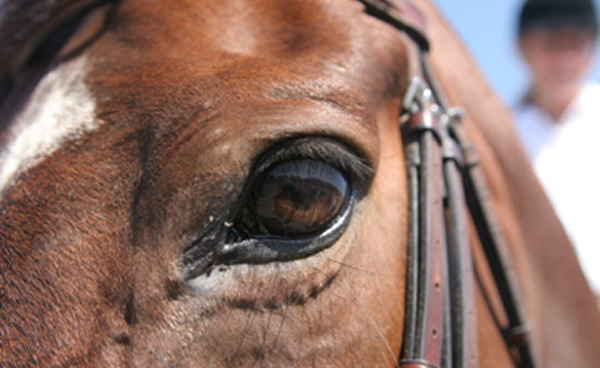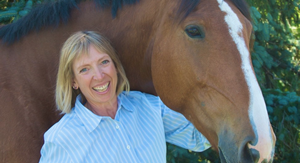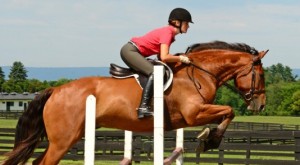Bring up words like “Centering”, “Energy” and “Chi” and what happens to most folks? They freeze up, hold garlic in your face and walk away thinking you are into all of that “woo-woo” stuff. So I suppose I have my work cut out for me to convince you that Centering is nothing more than efficient biomechanics – well almost.
Let’s start with Sally Swift’s description of Centering. Remember that Sally is now 87 years old. Sally learned about Centering when she was a child. It helped her deal with physical issues stemming from scoliosis (curvature of the spine). Sally worked with a woman named Mabel Todd. Ms. Todd taught Sally about Centering without ever using that word. Ms. Todd’s work is described in a book called “The Thinking Body”. There is also a recently produced video by the same name available.
In the book Centered Riding, Sally Swift describes the essentials of Centering in the following ways; “balance, control and energy”, “your center of gravity is lower”, “the upper body seems lighter, more stable and easier to handle”, “tensions that blocked the flow of energy through your body are released”, and “you will be relaxed and ready for the next movement or exercise”. All of these descriptions are accurate to riding or any other activity for that matter.
When someone is Centered they are calm, quiet and yet energized, full of life. Someone who is Centered observes everything around them. They are powerful but only use their power when necessary. They exude an underlying strength. They are in control of themselves and their actions. They only use the appropriate amount of energy to accomplish the task. Notice that this description could also apply to your horse. So Centering it is not just sitting staring at your navel. When someone is Centered their body and mind are available to do what ever is required. That might be standing quietly one moment and moving at full speed the next. I think of the sports description “being in the zone” as the equivalent to being Centered.
If any of you have an opportunity to meet Sally (by the way, she is still teaching clinics in Brattleboro, VT) you might understand Centering a little more. Sally is still spry and strong even though she sometimes totters around on two canes. There is an inner strength emanating from Sally that goes far beyond her physical strength. This inner strength comes from her center. Sally can stop strong men from bending her arm because she utilizes this power. She is not able to do body work on mounted riders anymore because she is unstable on her legs. However, Sally can project her energy across an arena or a lecture hall and keep the audience captivated for an entire evening.
Other examples of someone “Centered” can be found by looking at top athletes in any sport. Watch someone who is really good on a skateboard, in-line skates or skis. These athletes are balanced over their feet. The “Centered” ones look like there if little or no effort being exerted as they do flips, somersaults and turns. There are no extraneous movements. These athletes appear calm, “in the zone”. Everything is focused, fluid and balanced.
So now that you have an idea of what Centered looks like, the question is how do you achieve it? First let’s start with a little anatomy. Remember our discussion of the pelvis? The pelvis is like a bowl that your hip joints fit into on either side. At the back of the pelvis there is a triangular shaped bone called the sacrum. This is the base of your spine. The sacrum was originally several vertebrae, which are now fused together. The tailbone or coccyx hangs off the end of the sacrum. The sacrum attaches to the pelvis on each side of the triangle at the sacro-iliac joints.
When the pelvis is tipped forward and down (hollow back position) the sacrum points out behind like a duck’s tail. If you are sitting deep on your pockets your sacrum is curled way underneath you. When the pelvis is in a neutral position the sacrum hangs down curving slightly under you and your seat bones point downward.
In order to find your center start with your pelvis in a neutral position. Place the palm of one hand on your abdomen with your thumb on your navel. Place the other hand directly across at about the level of your waistline. Think of your center between your two hands. If you are standing while doing this, notice what happens if you think of your center being closer to your front hand than your back hand. Did you tip forward? Then think of your center lying closer to your back hand. Did you rock back on your heels? Find the place where your Center is between your two hands and you feel your weight evenly distributed over both your feet.
Now begin to walk around the room. Again think of your Center shifting forward and back. What happens to your walk? Then hold your breath or tighten your shoulders. Notice how your Center moves up and the quality of your walk changes. Then allow your Center to drop down into your pelvis and feel the difference. In this exercise you will notice that as you change your balance shifts and the quality of movement changes. Tension in the upper body causes the Center to shift upward. In order to remain deep in the saddle you want to let your Center stay down in your pelvis.
Once your Center is settled down in your pelvis think of it as the place where movement begins. In other words, before you ever move there needs to be a place where the movement initiates. If you start to move by tipping your head forward, you are already falling forward instead of stepping. If you start your movement from your feet then you will have a tendency to fall back with the upper body. If you start your movement from your Center then you will move as a whole, neither falling forward or back as you walk.
When you begin the movement from your Center you will be using more of your seat aids rather than tipping out of balance to cause the horse to move forward. Therefore, the horse will be in a better balance from the very first step. Once your Center remains in your deep in your pelvis you can begin to bring up the chi force or amount of energy and power. If your Center shifts out of your pelvis you cannot access the power that resides there. However when you can maintain your Center in your pelvis you can increase the amount of energy or chi, rather than relying on your physical strength. You might even say that increasing your life is increasing the flow of energy from your Center upward and forward while decreasing your life can occur by flowing your energy downward into the ground.
How does one begin to get the feeling of power emanating from their Center? Practicing any form of Martial Arts is a big help. All of the Martial Arts base their strength on the concept of the chi force coming from your Center. However, if you aren’t quite up to that, begin by first becoming aware of your Center. Then when you are going to ride a transition, think of the movement starting from Center rather than from your arms or legs. Let your entire body become part of the movement starting from your Center and expanding outward. Notice that the breathing really helps to keep your Center low and properly aligning your body will make it easier to keep your C enter down in your pelvis. Observe how much softer your contact is when you come from your Center rather than your arms.
Remember that Centering is a more elusive concept than the other Centered Riding Basics that we have discussed. Give it time to evolve in your mind and body. Notice how the concept changes with time and experience and enjoy the process along the way.
Copyright© 2000. All rights reserved.




